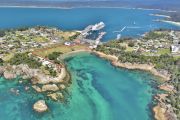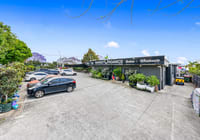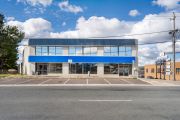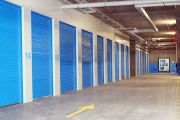
How this office building is saving money – and carbon
In March, landlord ISPT opened the doors to a new office offering in central Melbourne. The 34-level tower in the heart of the city’s legal and financial district is net zero in its operational carbon use, has no gas and is powered by renewable energy.
And it is 44 years old. The $21.5 billion fund manager opted to reuse the existing shell of the 500 Bourke Street building – fully occupied by NAB until 2021 – strip it out and refit the shell of the building, removing gas and making it fully electric.

ISPT’s retrofit at 500 Bourke is part of a growing trend to extend the life of existing office structures rather than demolish and rebuild. It is the company’s third retrofit project, and ASX-listed developer and landlord Stockland has plans for a similar project.
The decision to spend $160 million on a retrofit of the 1977 building – one of the featured sites in this year’s Open House Melbourne public architecture weekend – reflected the growing need to tackle embodied carbon emissions, says chief sustainability officer Steven Peters.
“There’s been a strong focus on operational emissions,” Peters says, referring to the carbon emissions associated with ongoing energy use from systems such as heating, cooling, ventilation and lighting.
“Now we’re seeing operational emissions starting to reduce … we now have to shift our attention to the materials that go into the building.”
Retaining the concrete and carbon shell of the Fender Katsalidis-redesigned Bourke Street tower saved an estimated 57,000 tonnes that ISPT estimates it would have generated by manufacturing and constructing a new structure.
Saving carbon – and dollars
To put that in context, ISPT’s 94-building portfolio – with a net lettable area of 1.7 million square metres – has an annual operational emissions output of 31,000 tonnes.
“Almost double the operational emissions of the portfolio were saved by retaining the building,” he says.
The cost difference is also striking. ISPT could have demolished the building and built a new tower of 85,000 square metres on the 4000-square-metre site, a build that industry estimates put at between $338 million and $383 million in 2021 dollars ($412 million-$467 million today).
As operational carbon emissions reduce, driven by landlords and tenants mindful of meeting their own sustainability commitments, the significance of embodied carbon will grow. Life insurer TAL signed up as anchor tenant to 500 Bourke Street in 2022.
By 2050 embodied carbon will account for 85 per cent of Australia’s built environment emissions, up from 16 per cent in 2019, federal buildings rating scheme NABERS says.
And rules around embodied carbon are tightening. Legislation supporting Australian Sustainability Reporting Standards requiring tighter carbon disclosure – through an additional “sustainability report” that will be included in annual financial reporting – kicks in from this financial year.

The very largest companies – those with more than $1 billion in assets, $500 million in revenue or 500 employees – are first off the rank, with the disclosure requirements expanding to smaller companies over the following three years. Small- and medium-sized businesses are not included.
“This sustainability report primarily requires businesses to outline climate resilience risks and opportunities relating to their physical premises or business activities,” says Tim Spies, the managing director for community and place at consultancy Aurecon, which advised ISPT on the 500 Bourke Street project.
“It also requires businesses to disclose their operational emissions footprint, and it is in collecting this data and in defining the scope boundaries considered that companies will require concerted effort and industry standardisation over the next few years, until this becomes business-as-usual operations.”
The market for office buildings is putting a premium on more sustainable buildings.

“We’re starting to see the tenants pushing and advocating for these as well,” says Nicole Ward, head of ISPT’s office portfolio.
“We’re starting to see the tenants pushing and advocating for these as well. If you’re not doing it, the risk is that you don’t get the tenants.”
An EY report this year, Zeroing in on net zero buildings, showed that buildings with Green Star design (pre-construction) and as-built (post-construction) ratings had higher occupancy rates, longer weighted average lease expiries and lower capitalisation rates (reflecting yield).
ASX-listed developer and landlord Stockland changed tack this year on plans to demolish and rebuild its 133 Castlereagh Street head office tower in Sydney, declaring it instead planned to preserve about 23,000 tonnes of embodied carbon by preserving the substructure as well as the concrete and steel structure of the adjoining 32-storey and 14-storey office towers.
ISPT is now on its third retrofit project. In Sydney, it is doing a ground plane and facade upgrade at 477 Pitt Street, which should be complete in April, and at its 25-storey tower at 270 Pitt Street it has embarked on a full retrofit akin to 500 Bourke Street, costing $170 million.
But the decision about any building has to be specific to that building and what the next tenant would pay for it, Ward says. That informed the decision to go ahead with 270 Pitt Street.
“Where does the building sit within the market? What is the likely target tenant for the building? Where would the likely rent be sitting?” she says.
“That influences how much capital we put into the building to ensure it is a viable outcome for investors.”











